Header: Red-necked Wallabies are some of the regularly-seen wildlife on David and Alison’s property.
In the mid-1990s in retirement, we decided to have a ‘tree change’ from small acreage in Brisbane to larger acreage near a nice country town up or down the coast and adjacent hinterland. After much investigation, we settled on the Maleny area on the Blackall Range inland from the Sunshine Coast, but it took a further 18 months for the right block of land to come on the market. Five kilometres outside Maleny at Reesville, it was 13 ha of north-facing, steep, ex-dairy farm land with two creeks, some areas of regrowth forest, plenty of lantana and large cattle grazing areas. We built our new house in the middle of the property and began our new lifestyle in January 1999.
After joining Barung Landcare based in Maleny, we undertook their land management course and learnt that many local Barung members were working on their properties to restore the sub-tropical rainforest that had covered the whole Blackall Range before it was cleared more than a century ago. We decided that restoring the rainforest wildlife habitat on our property was a very worthwhile retirement project for us.
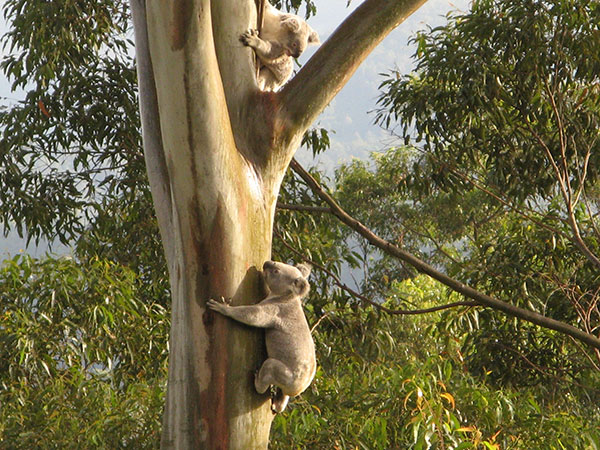
Male Koalas in pursuit of females.
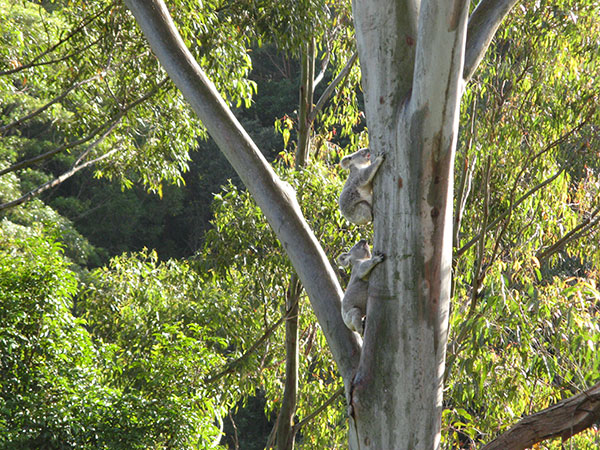
Male Koalas in pursuit of females.
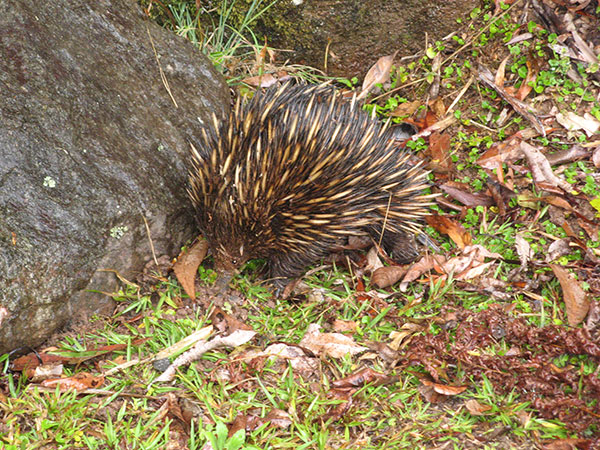
Echidna Regularly seen Wildlife
There was a lot to learn as we began the long staged program of progressively removing the abundant woody weeds (lantana, privet, camphor laurel, wild tobacco, blackberry) and planting and mulching local sub-tropical rainforest trees, as well as encouraging regeneration of self-sown ones. The hole-digging and tubestock planting proved to be only the start of our tree growing endeavour, with the ongoing maintenance of each of the planted areas requiring a lot of time and effort until the developing tree canopy started to assume control five or more years later.
Swamp Wallabies took a liking to a number of the species we were planting and we had to make cages to protect them until they were tall enough to be out of reach, then we re-used the cages. Because of the steep topography and creek gullies, access across the property was only by foot and everything had to be carried manually, including tools, trays of tree tubes and some bales of hay for mulching.
We always planted our trees during the summer wet season and in some years,
by the end of the dry season six to nine months after planting, supplementary watering of the new trees was needed; which we did where feasible. After the first major planting in the far west of the property in January 2000, watering of 1000 trees was done twice by bucket that winter from a small waterhole in a tributary creek. In later years, if the required watering was close enough to the house, multiple hoses were joined together for watering from the house tanks by hosing and bucketing.
We enjoyed doing as much as possible of the work ourselves, but ageing and health problems in recent years have forced us to use more outside help. In total, we have so far planted about 7000 trees of 149 local species with many more self-sown. To our great satisfaction, our earlier planted areas now have substantial canopy cover that, together with the pre-existing remnant and regrowth trees, will slowly mature into our future rainforest. At the same time, local native understory species are spreading, including ginger, cunjevoi, ferns and epiphytes such as elkhorns, staghorns and birdnest ferns.
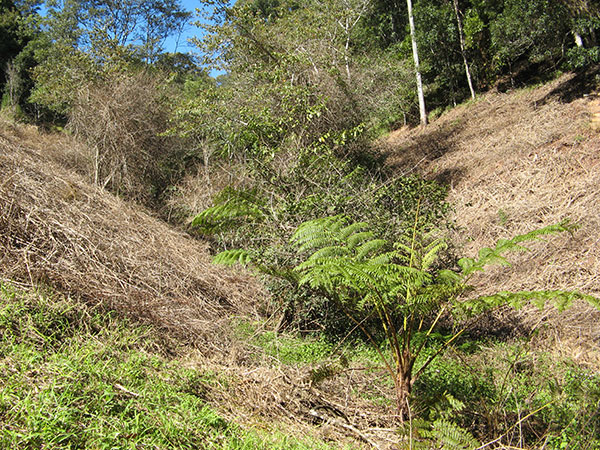
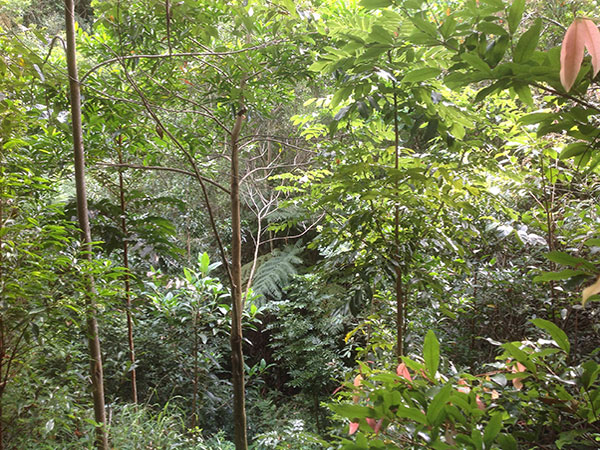
Before (Left) and After (Right): This creek gully was a sea of thick lantana before it was cleared (as shown above) and then planted with sub-tropical rainforest trees. Four years later, in January 2015, the ‘After’ photo shows a mass of young greenery. Often where thick lantana has been removed, many woody weeds and native trees germinate.
With the trees advancing across the property, the shrinking grass areas are grazed by our last two ‘lawn mower’ steers which are growing old with us. We would have preferred not to have cattle, but they are essential for this steep property’s management.
“We have so far planted about 7000 trees and 149 local species”
All of our large-acreage immediate neighbours have lots of the woody weed species and it is disappointing that none of them has shown any interest in removing the weeds or planting native trees. Furthermore, the seeds from woody weeds on neighbouring properties and roadsides are spread by birds and give us the unwanted extra burden of continually finding and removing their seedlings that are germinating all over our property.
Most of all, we love living here surrounded by the natural environment of our developing forest habitat and its array of native wildlife. This is busy Koala territory because the scattered regrowth eucalypts and Brush Box have thrived in the rich volcanic soil. Having no domestic pets, we see Koalas around our house on most days, as well as many other native animals periodically, including Red-necked Wallabies, echidnas, Mountain Brushtail Possums and a range of reptile species. Twice Carpet Pythons have mated and incubated eggs in the rock wall next to the house.
Amongst the exploits of the small nocturnal animals, we’ve seen a glider being pursued between trees by an owl at dusk and had an antechinus mother with babies trying to build a nest in the glovebox of our car. The many bird species we hear and see include Green Catbirds and Wompoo Fruit-doves. On the downside, when the leeches and ticks are in season, they are waiting for us as we walk around the property.
Observing Koala behaviour during our years here has been a very special experience. In our early days, while we knew what the male Koala call sounded like, we didn’t know what creature was making the loud screeching noises at night. Then one day we heard both of these sounds coming from a tree near the house in daylight and saw that it was a male Koala pursuing a female who was resisting his advances. That was the first of many sightings of this kind of behaviour, though sometimes it is a male trying to separate a mother and baby so that he can get to the mother. Strangely, male and female Koalas don’t seem able to agree on the female’s readiness and willingness to mate. We have also discovered that Koala activity is not wholly nocturnal as we regularly see them on the move during the day, sometimes travelling considerable distances on the ground between trees; yet they can also stay in exactly the same tree spot for several days at a time. Koalas sometimes sit in species of trees other than eucalyptus and Brush Box and even browse on them.
To provide homes for other arboreal wildlife, nesting boxes have been installed to supplement the very few natural tree hollows on our property. Further down on the steep slopes, there are patches of naturally occurring Richmond Birdwing Vine amongst the few rainforest remnants that survived in the deep creek gullies.
Our rainforest restoration is not only a satisfying retirement project but also an educational process. We have learnt much about local native and non-native plants, wildlife behaviour, weather patterns and a wide range of activities from tree planting and weed control to constructing bush steps and fencing. Most importantly, our restoration of wildlife habitat is a tiny but worthwhile reversal of human destruction of the natural environment.
We have been Land for Wildlife members for many years and also have a Voluntary Conservation Agreement with covenant on our whole property arranged through our Land for Wildlife Officer, Nick Clancy, who has always been very helpful to us.
Article and photographs by David and Alison McDonald Land for Wildlife members Maleny, Sunshine Coast

I stumbled on your letter whilst trying to find out if there were koalas in these rangers.
I congratulate you on your efforts and results
It is a pity your neighbours are not interested in following your example.